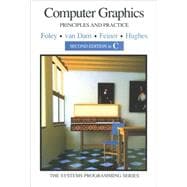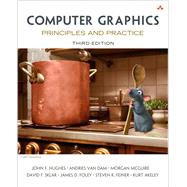Computer Graphics Principles and Practice in C

Computer Graphics Principles and Practice in C
- ISBN 13:
9780201848403
- ISBN 10:
0201848406
- Edition: 2nd
- Format: Hardcover
- Copyright: 08/04/1995
- Publisher: Addison-Wesley Professional
- Newer Edition
Note: Supplemental materials are not guaranteed with Rental or Used book purchases.
Extend or Purchase Your Rental at Any Time
Need to keep your rental past your due date? At any time before your due date you can extend or purchase your rental through your account.
Summary
"Interactive graphics is a field whose time has come. Until recently it was an esoteric specialty involving expensive display a hardware, substantial computer resources, and idiosyncratic software. In the last few years, however, it has benefited from the steady and sometimes even spectacular reduction in the hardware price/performance ration (E.G., personal computers for home or office with their standard graphics terminals), and from the development of high-level , device -independent graphics packages that help make graphics programming rational and straightforward. Interactive graphics is now finally ready to fulfill its promise to provide us with pictorial communication and thus to become a major facilitator of man/machine interaction." (From preface, Fundamentals of Interactive Computer Graphics, James Foley and Andries van Dam, 1982)
This assertion that computer graphics had finally arrived was made before the revolution in computer culture sparked by Apple's Macintosh and the IBM PC and its clones. Now even preschool children are comfortable with interactive-graphics techniques, such as the desktop metaphor for window manipulation and menu and icon selection with a mouse. Graphics-based user interfaces have made productive users of neophytes, and the desk without its graphics computer is increasingly rare.
At the same time that interactive graphics has become common in user interfaces and visualization of data and objects, the rendering of 3D objects has become dramatically more realistic, as evidenced by the ubiquitous computer-generated commercials and movie special effects. Techniques that were experimental in the early eighties are now standard practice, and more remarkable "photorealistic" effects are around the corner. The simpler kinds of pseudorealism, which took hours of computer time per image in the early eighties, now are done routinely at animation rates (ten or more frames/second) on personal computers. Thus "real-time" vector displays in 1981 showed moving wire-frame objects made of tens of thousands of vectors without hidden-edge removal; in 1990 real-time raster displays can show not only the same kinds of line drawings but also moving objects composed of as many as one hundred thousand triangles rendered with Gouraud or Phong shading and specular highlights and with full hidden-surface removal. The highest-performance systems provide real-time texture mapping, anitialiasing, atmospheric attenuation for fog and haze, and other advanced effects.
Graphics software standards have also advanced significantly since our first edition. The SIGGRAPH Core '79 package, on which the first edition's SGP package was based, has all but disappeared, along with direct-view storage tube and refresh vector displays. The much more powerful PHIGS package, supporting storage and editing of structure hierarchy, has become an official ANSI and ISO standard, and it is widely available for real-time geometric graphics in scientific and engineering applications, along with PHIGS+, which supports lighting, shading, curves, and surfaces. Official graphics standards complement lower-level, more efficient de facto standards, such as Apple's QuickDraw X Window System's Xlip 2D integer raster graphics package, and Silicon Graphics' GL 3D library. Also widely available are implementations of Pixar's RenderMan interface for photorealistic rendering and Post Script interpreters for hardcopy page and screen image description. Better graphics software has been used to make dramatic improvements in the "look and feel" of user interfaces, and we may expect increasing use of 3D effects, both for aesthetic reasons and for providing new metaphors for organizing and presenting, and navigating through information.
Perhaps the most important new movement in graphics is the increasing concern for modeling objects, not just for creating their pictures. Furthermore, interest is growing in describing the time-varying geometry and behavior of 3D objects. Thus graphics is increasingly concerned with simulation, animation, and a "back to physics" movement in both modeling and rendering in order to create objects that look and behave as realistically as possible.
As the tools and capabilities available become more and more sophisticated and complex, we need to be able to apply them effectively. Rendering is no longer the bottleneck. Therefore researchers are beginning to apply artificial-intelligence techniques to assist in the design of object models, in motion planning, and in the layout of effective 2D and 3D graphical presentations.
Today the frontiers of graphics are moving very rapidly, and a text that sets out to be a standard reference work must periodically be updated and expanded. This book is almost a total rewrite of the Fundamentals of Interactive Computer Graphics, and although this second edition contains nearly double the original 623 pages, we remain painfully aware of how much material we have been forced to omit.
Major differences from the first edition include the following:
- The vector-graphics orientation is replaced by a raster orientation.
- The simple 2D floating-point graphics package (SG) is replaced by two packages--SRGP and SPHIGS--that reflect the two major schools of interactive graphics programming. SRGP combines features of the QuickDraw and Xlib 2D integer raster graphics packages. SPHIGS, based on PHIGS, provides the fundamental features of a 3D floating-point package with hierarchical display lists. We explain how to do applications programming in each of these packages and who how to implement the basic clipping, scan conversion, viewing, and display list traversal algorithms that underlie these systems.
- User-interface issues are discussed at considerable length, both for 2D desktop metaphors and for 3D interaction devices.
- Coverage of modeling is expanded to include NURB (nonuniform rational B-spline) curves and surfaces, a chapter on solid modeling, and a chapter on advanced modeling techniques, such as physically based modeling, procedural models, factals, L-grammar systems, and particle systems.
- Increased coverage of rendering includes a detailed treatment of antialiasing and greatly expanded chapters on visible-surface determination, illumination, and shading, including physically based illumination models, ray tracing, and radiosity.
- Material is added on advanced raster graphics architectures and algorithms, including clipping and scan-conversion of complex primitives and simple image-processing operations, such as compositing.
- A brief introduction to animation is added.
This text can be used by those without prior background in graphics and only some background in Pascal programming, basic data structures and algorithms, computer architecture, and simple linear algebra. An appendix reviews the necessary mathematical foundations. The book covers enough material for a full-year course, but is partitioned into groups to make selective coverage possible. The reader, therefore, can progress through a carefully designed sequence of units, starting with simple, generally applicable fundamentals and ending with more complex and specialized subjects.
Basic Group. Chapter 1 provides a historical perspective and some fundamental issues in hardware, software, and applications. Chapters 2 and 3 describe, respectively, the use and the implementation of SRGP, a simple 2D integer graphics package. Chapter 4 introduces graphics hardware, including some hints about how to use hardware in implementing the operations described in the preceding chapters. The next two chapters, 5 and 6, introduce the ideas of transformations in the plane and 3-space, representations by matrices, the use of homogeneous coordinates unify lin







